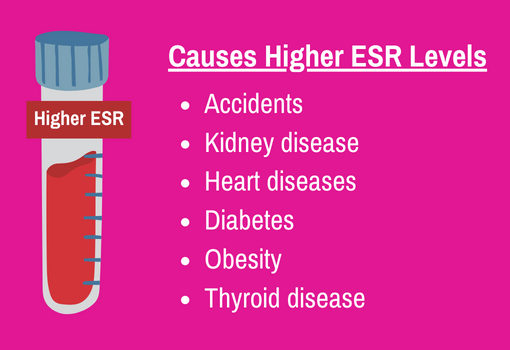When it comes to viral infections, various signs and symptoms can indicate your infection. But do you know? These viral infections can also influence your ESR levels.
This article discusses what ESR is all about and the relationship between viral infections and ESR levels.
What is ESR?

Erythrocyte Sedimentation Rate (ESR) is a blood test that measures the rate at which red blood cells sink to the bottom of a test tube. The higher the rate of settlement, the higher inflammation.
The ESR does not diagnose one particular condition; it helps doctors understand if you are experiencing inflammation and whether further tests are needed. The test also can help monitor already existing inflammatory diseases.
If your doctor suspects high inflammation levels in the body, he may recommend an ESR test.
How Does the ESR Blood Test Work?
The test is based on the idea that when blood is put into a tube, red blood cells would eventually fall to the bottom of the tube due to gravity. The ESR test determines how far red blood cells settle in a specific period, often an hour.
When you experience inflammation, it affects RBCs in several ways. Initially, your red blood cells cling to each other and form clumps, which impacts their sedimentation rate inside a tube containing a sample of your blood.
Also, people with an acute infection or chronic inflammation may have more proteins in their RBCs. This can make them settle rapidly.
Overall, the pace at which your RBCs settle determines your ESR. The quicker this process occurs, the greater your ESR levels will be, indicating a higher likelihood of inflammation in your body.
What Causes Higher ESR Levels?

High ESR levels are attributed to several conditions. Most of these conditions include inflammatory diseases. Some of them are as follows:
- Systemic inflammatory infection: it includes infections that can affect the heart, lungs, bone and skin.
- Tissue injury or ischemia (inadequate blood supply to a body part)
- Accidents
- Kidney disease
- Heart diseases
- Diabetes
- Obesity
- Thyroid disease
The above list is not comprehensive; other conditions like pregnancy or anemia can also result in high ESR levels. Drugs such as cortisone, vitamin A supplements, theophylline, quinine, and methyldopa could also impact your ESR test results.
Is ESR Elevated in Viral Infection?
The body’s defense mechanism against the virus may cause an elevation in the ESR levels during viral infections. But the degree of the elevation can vary based on the type and severity of the infection.
However, it is important to note that ESR is a non-specific test that can influence ESR levels in various conditions.
ESR Test Results
The amount of plasma left at the test tube’s top after an hour is the ESR test result.
As the test does not provide specific information about a particular health condition, healthcare professionals must consider the results and other clinical data to make a precise diagnosis and determine if the individual is suffering from a disease.
The normal ESR range lies between 0 to 20 millimeters per hour. People who fall outside the normal ESR range may have a medical indication. Generally, an ESR value of 30 mm/hr or higher is considered significantly elevated, indicating inflammation or infection.
While low ESR levels may indicate certain medical diseases, moderately elevated ESR value does not always indicate a health condition.
Conclusion
In conclusion, an ESR test shows inflammation in your body by measuring the rate RBCs settle in the test tube.
Apart from other conditions that can cause an elevation in ESR levels, viral infections can also elevate your ESR levels, and the degree of elevation can vary depending on the type of infection.
FAQs
1. What is the ESR level in cancer patients?
Cancer patients may have ESR levels ranging between 0 to 10 mm/hr or higher than 100 mm/hr.
2. How long does a viral infection last?
A viral infection will usually last a week or two. However, this can seem like a very long period if you’re feeling rotten.
3. Does the ESR level increase in fever?
Yes, the ESR level can increase in fever. Fever is a typical symptom of inflammation, and ESR is a general indicator of inflammation in the body.


